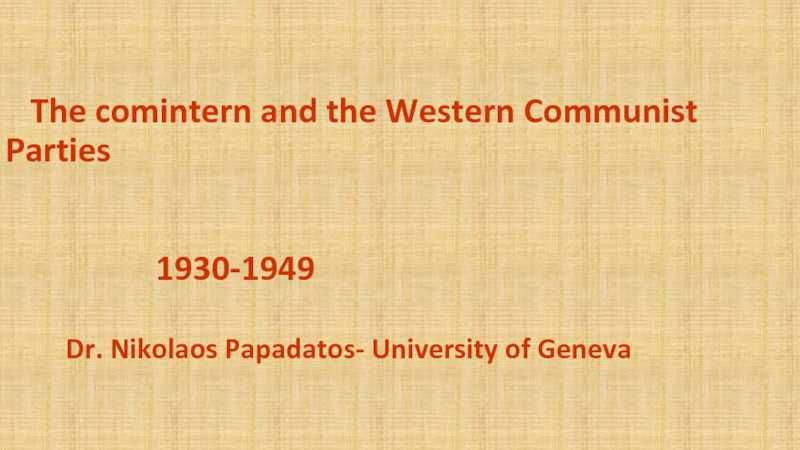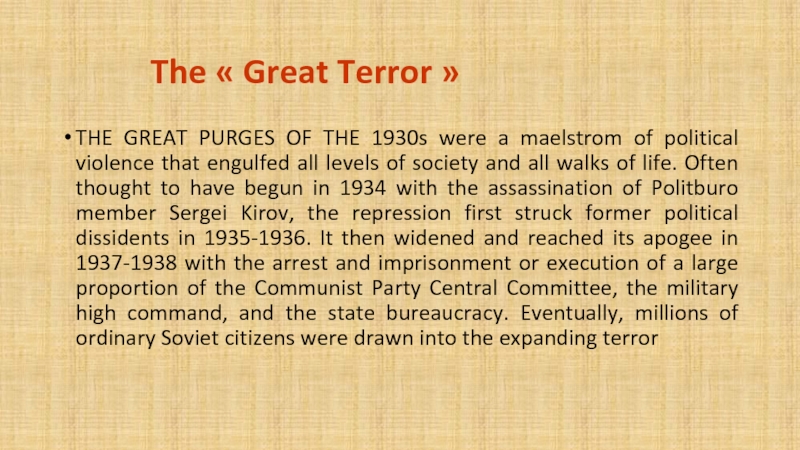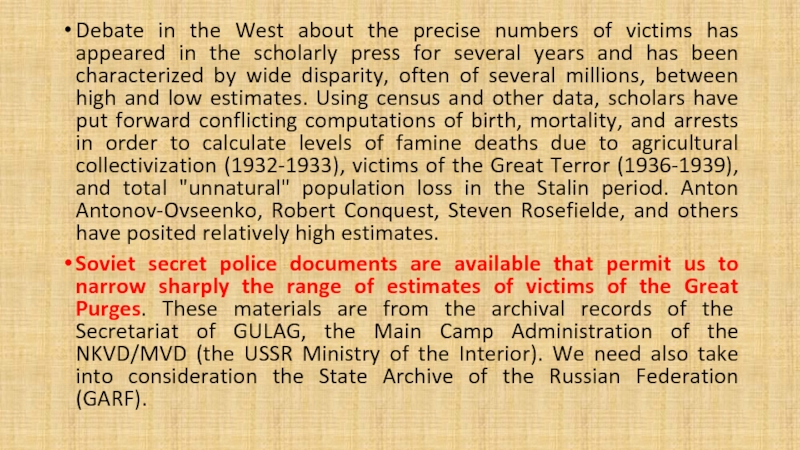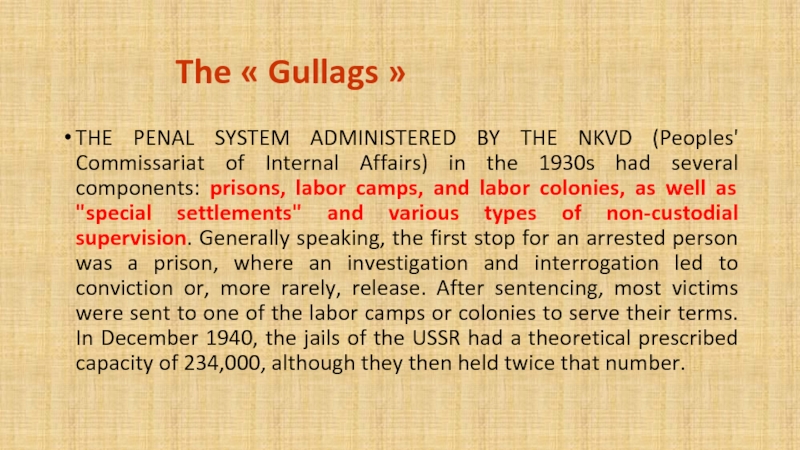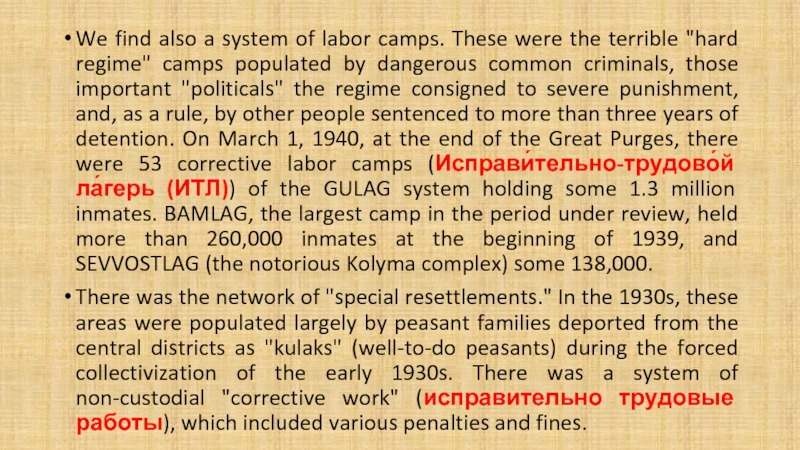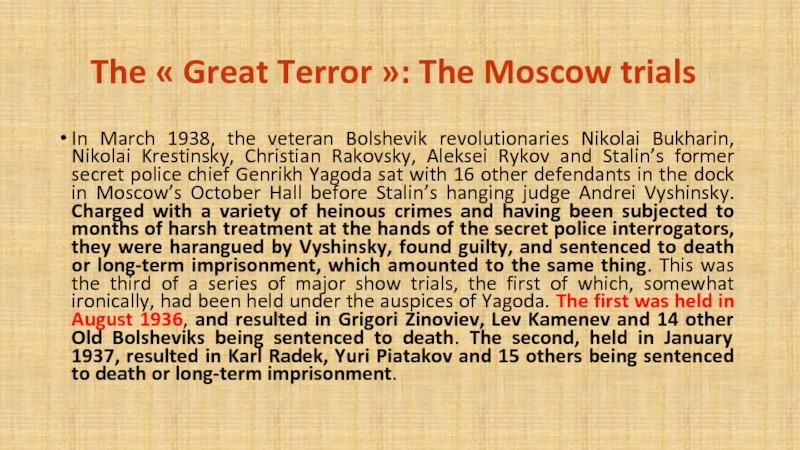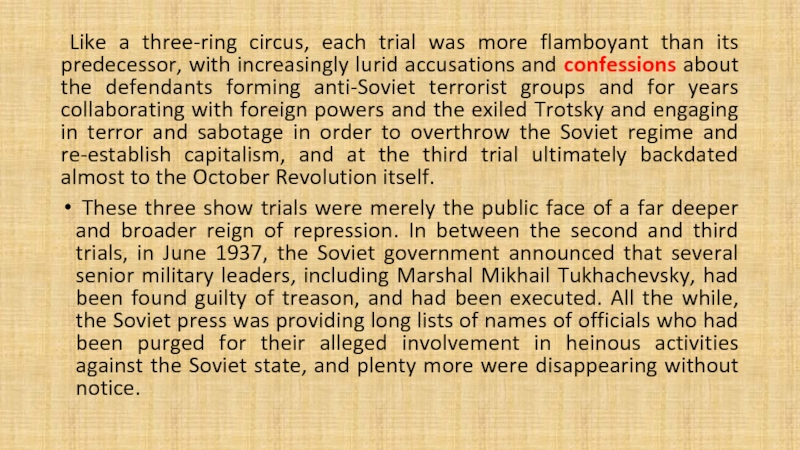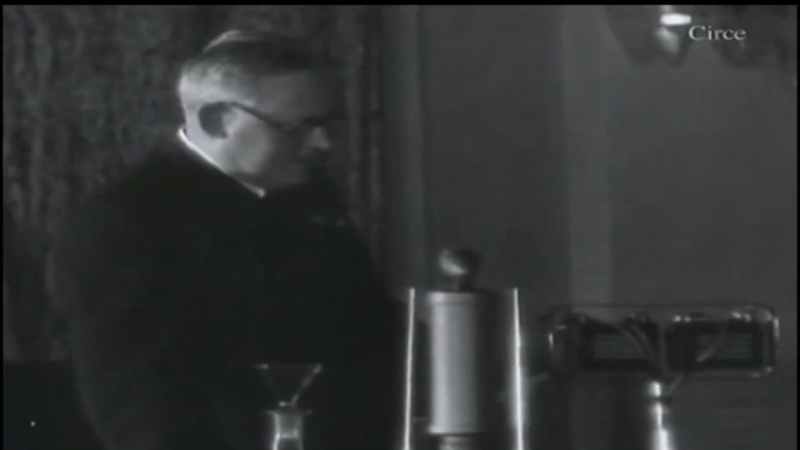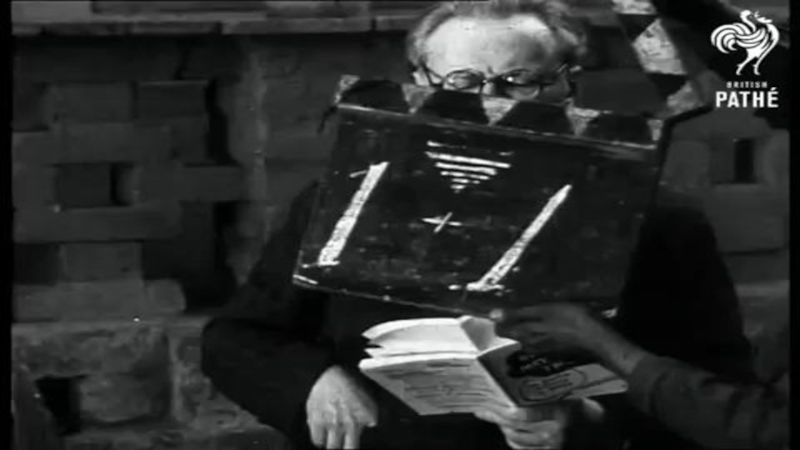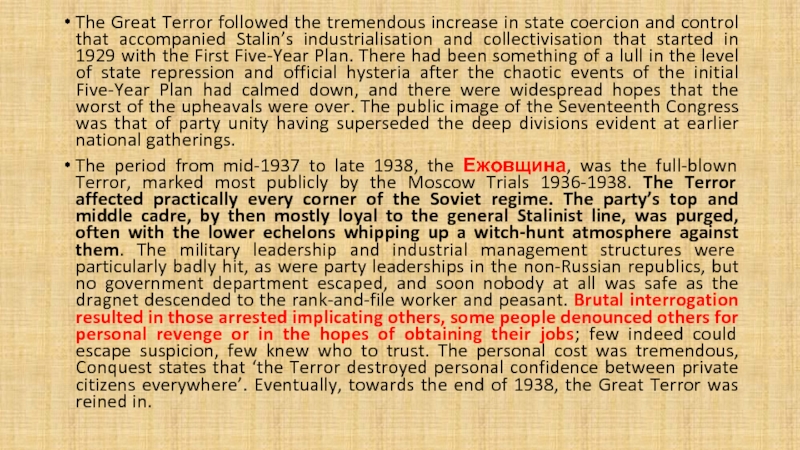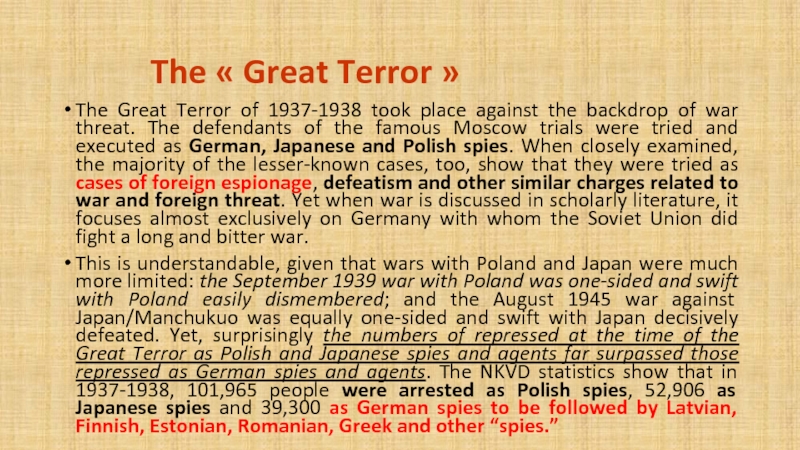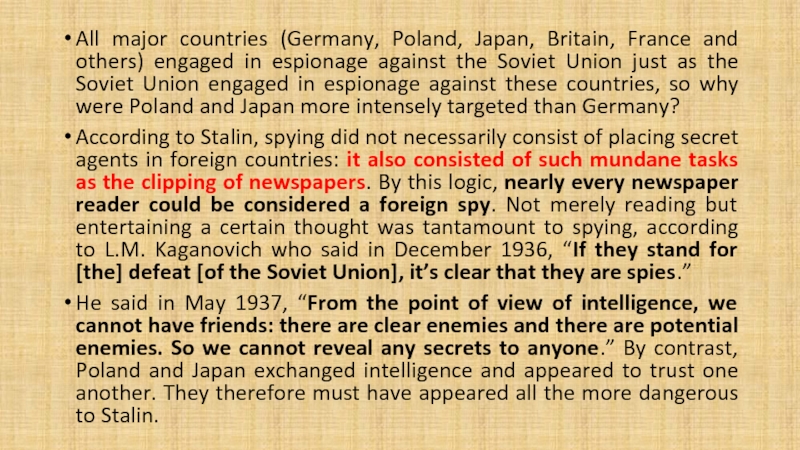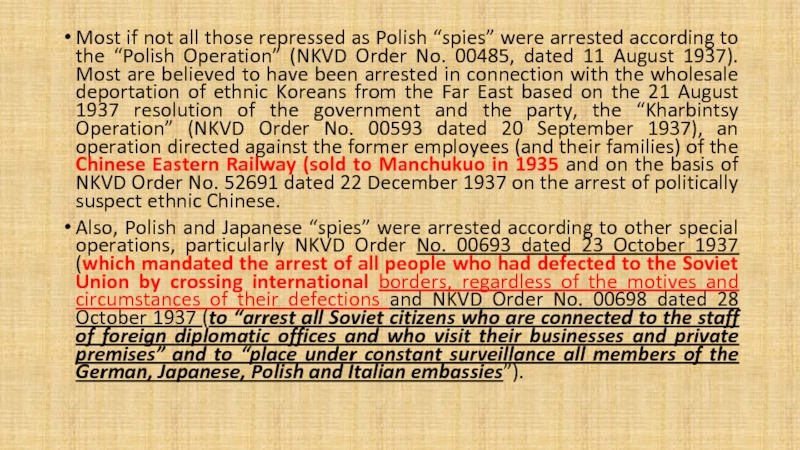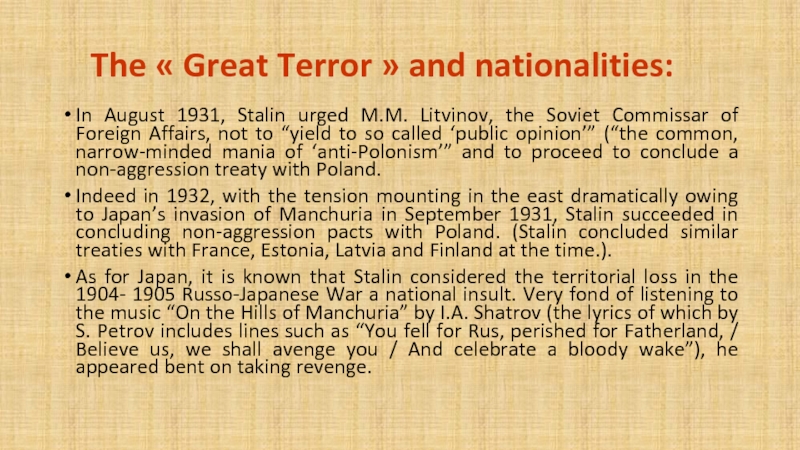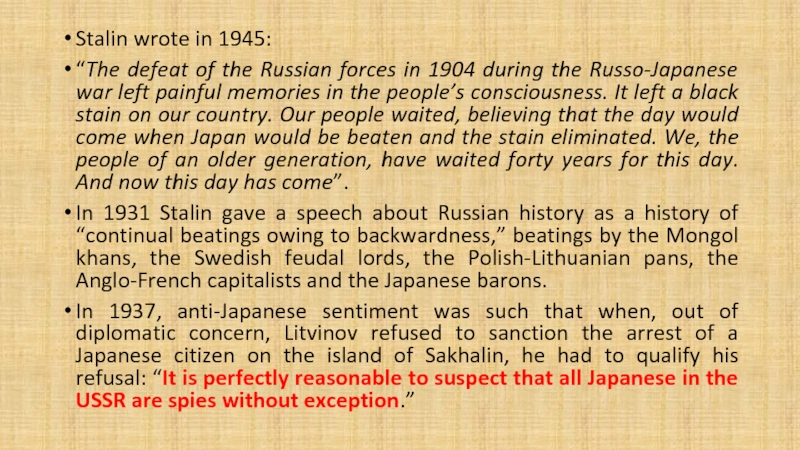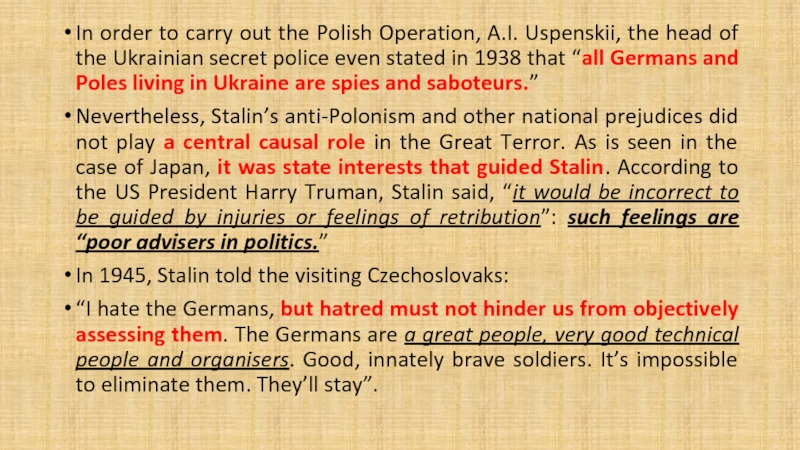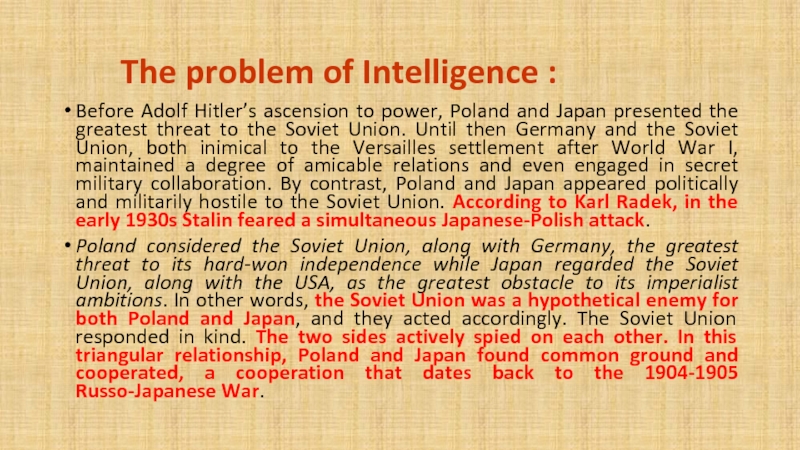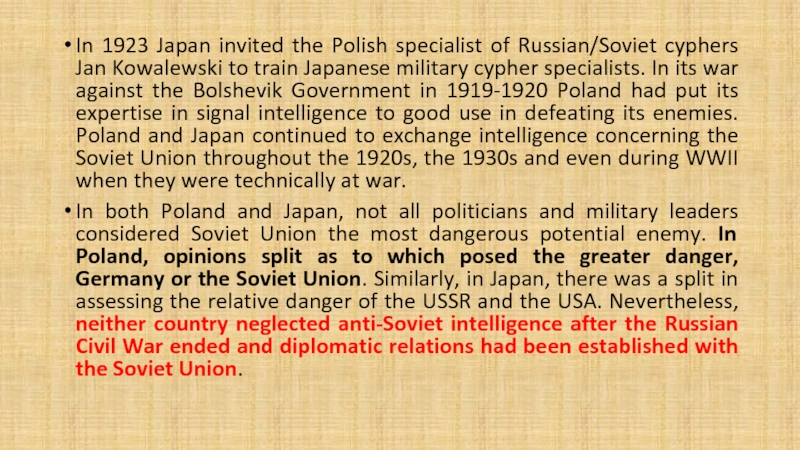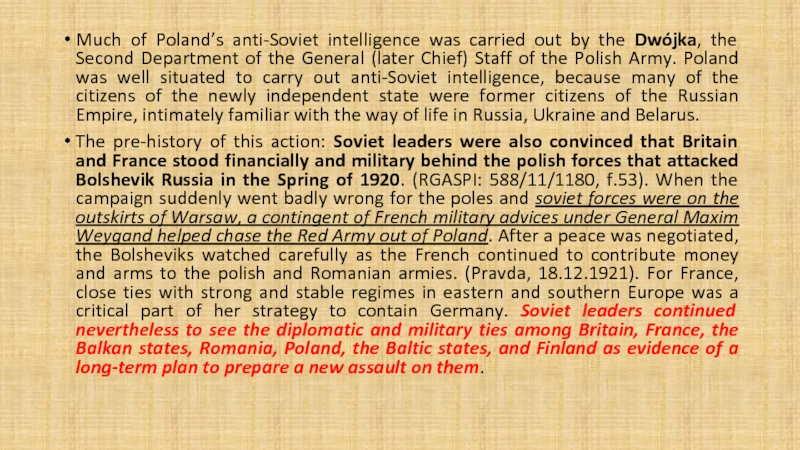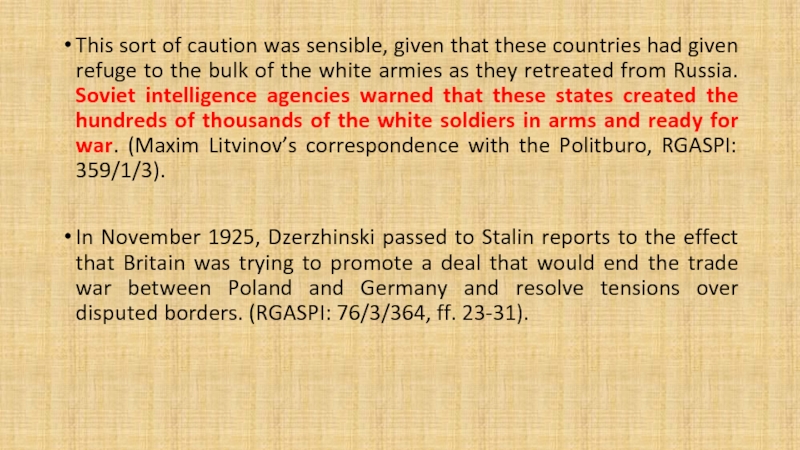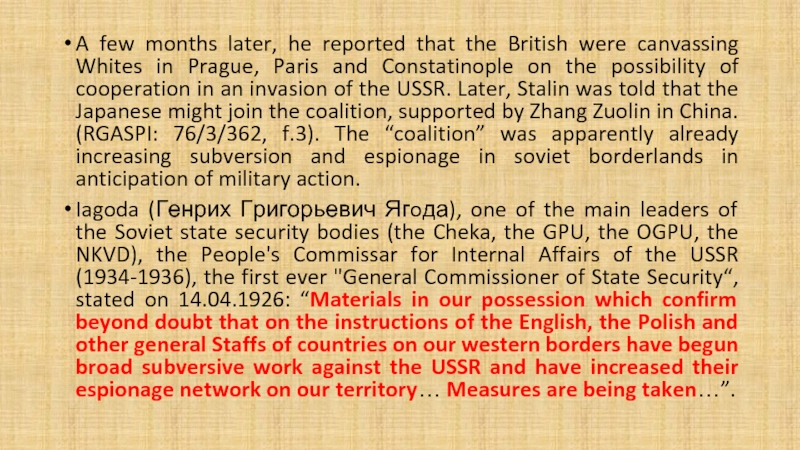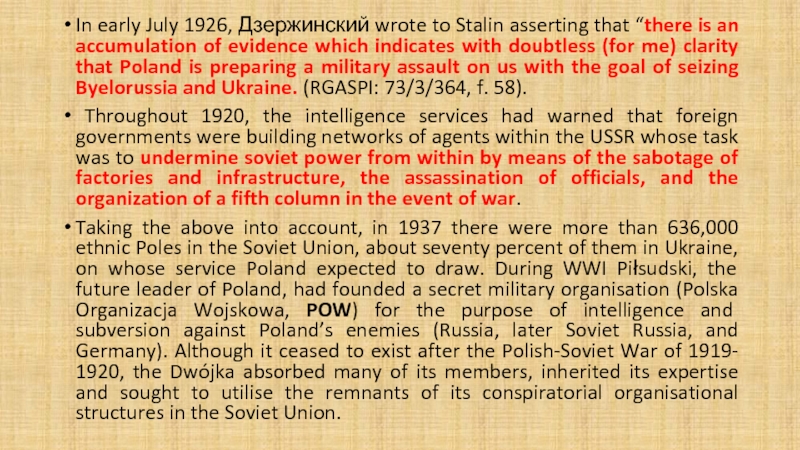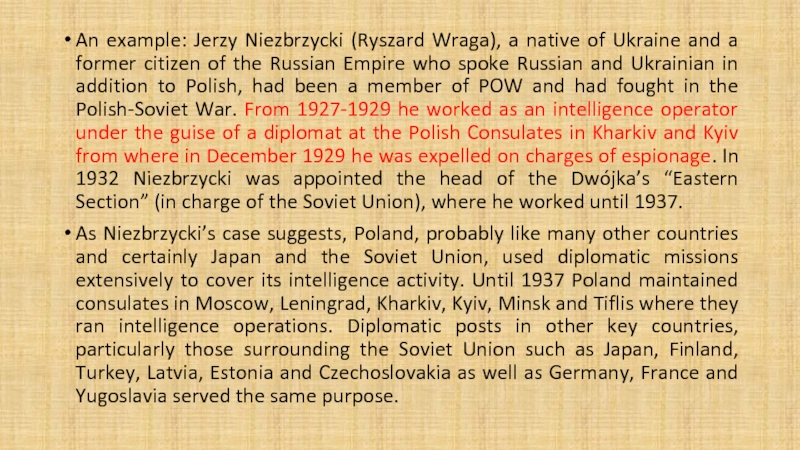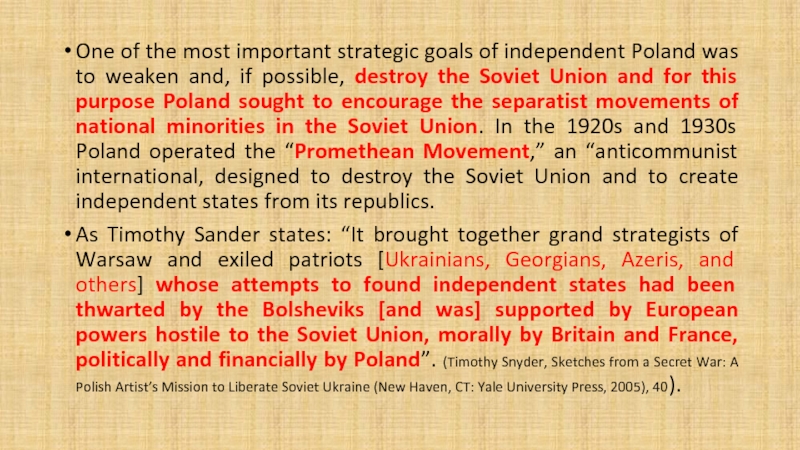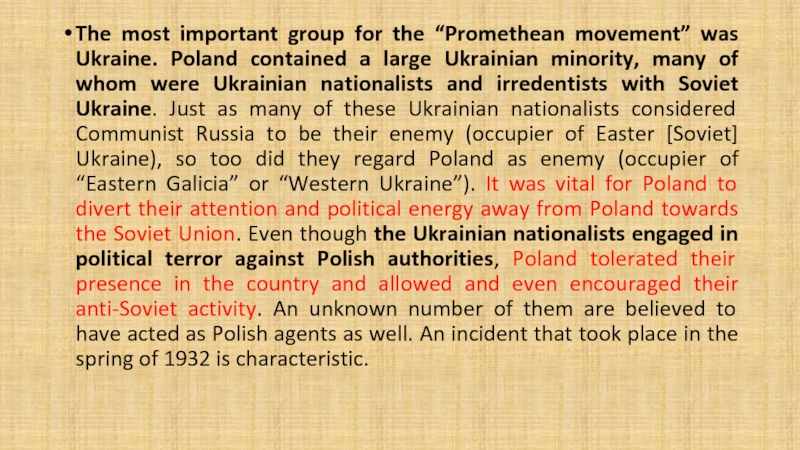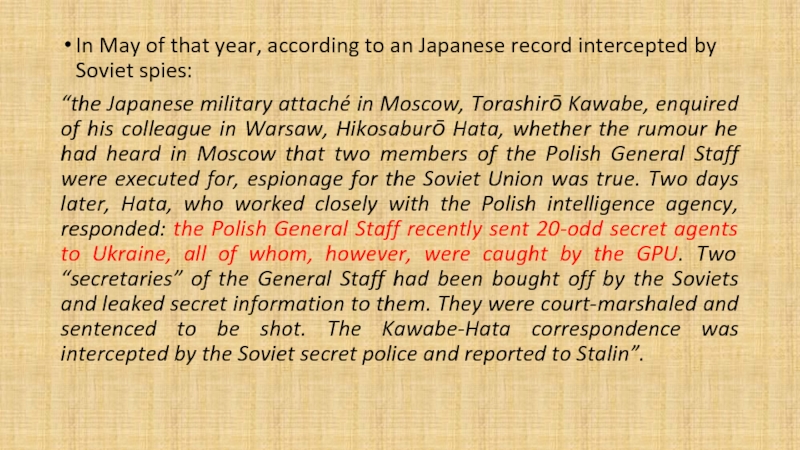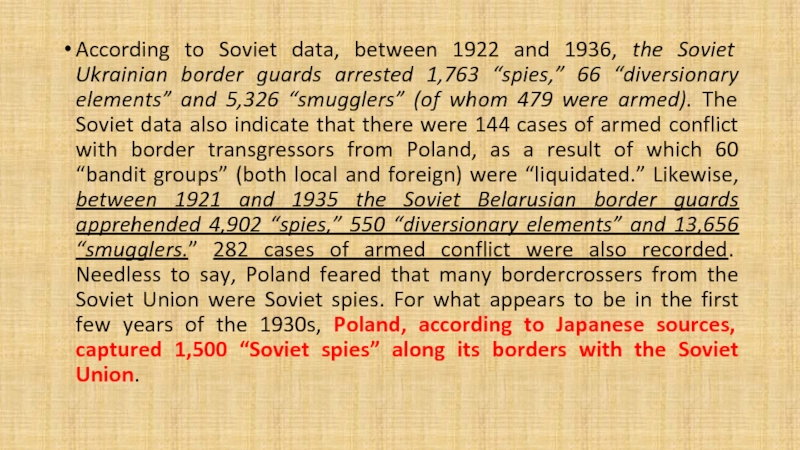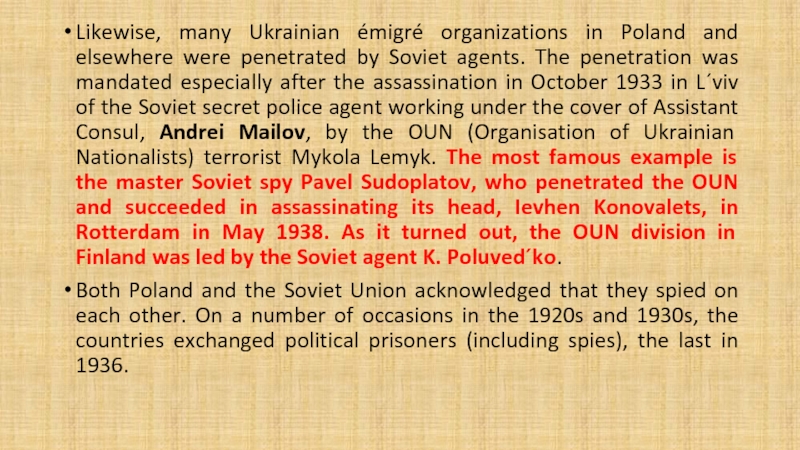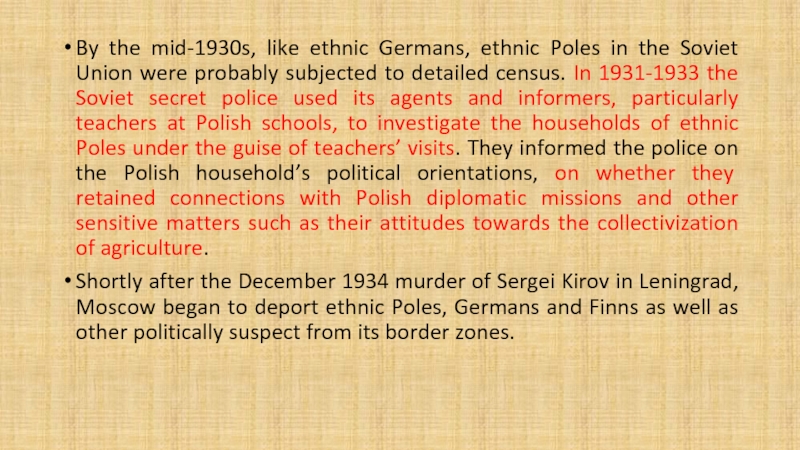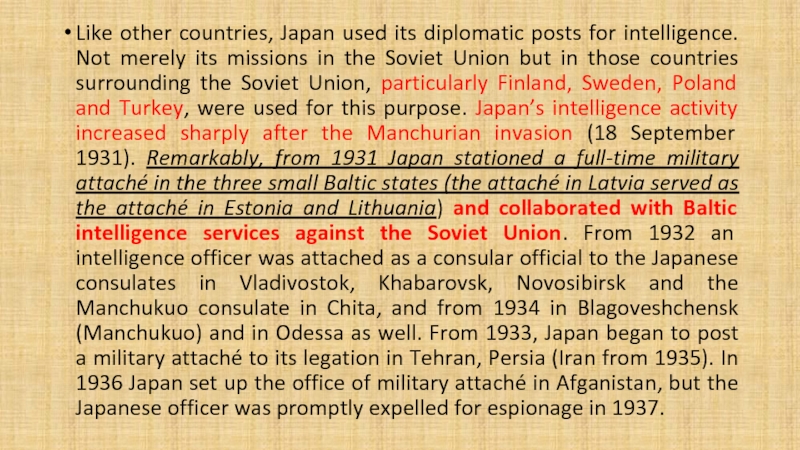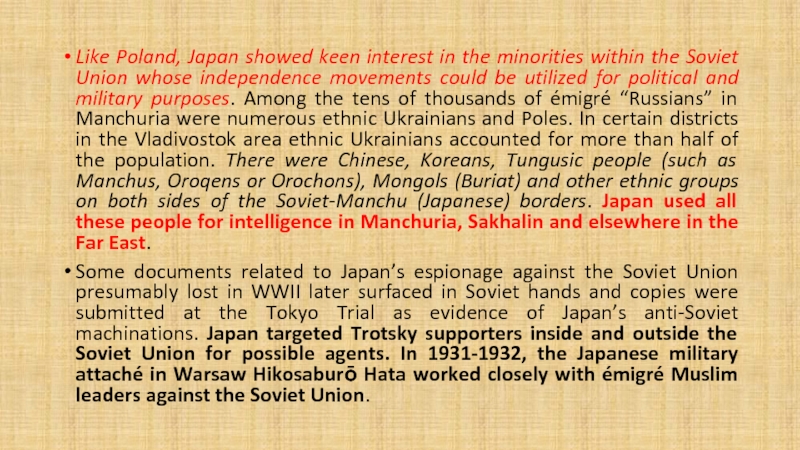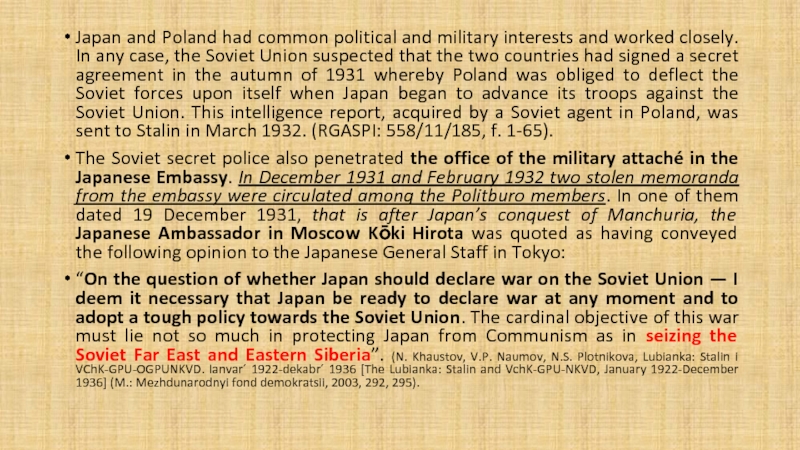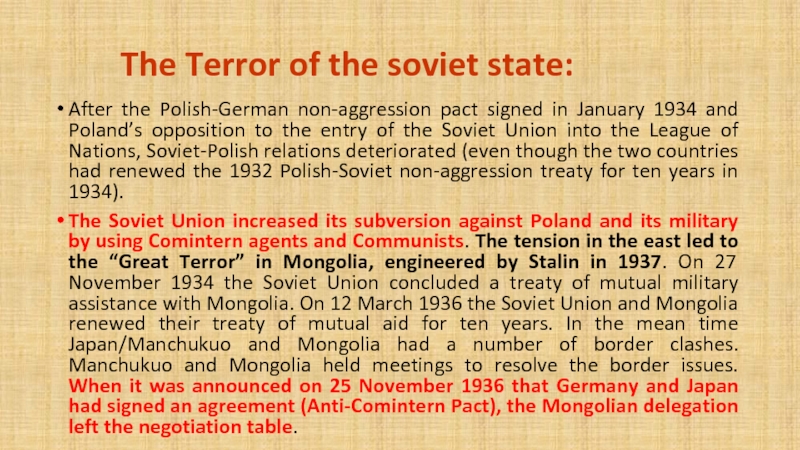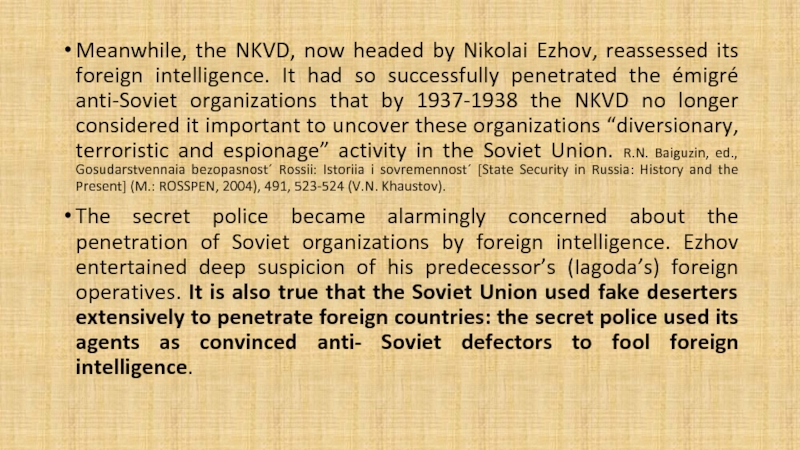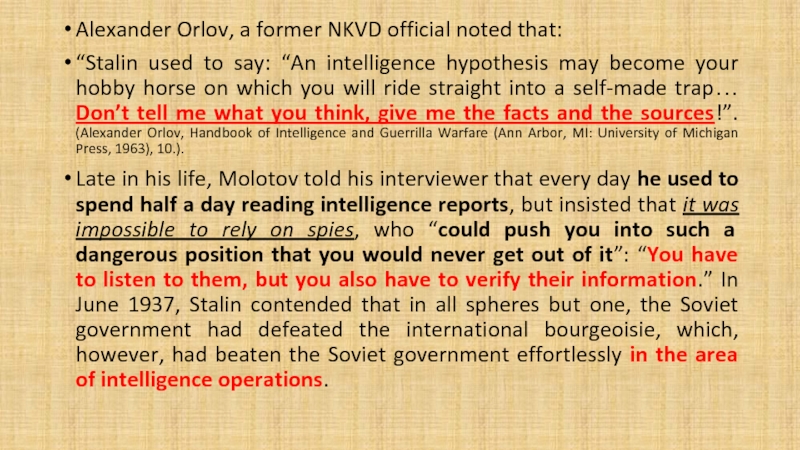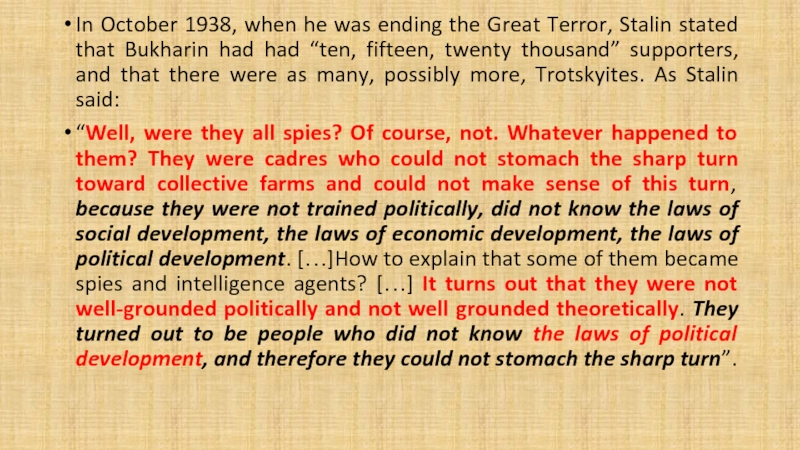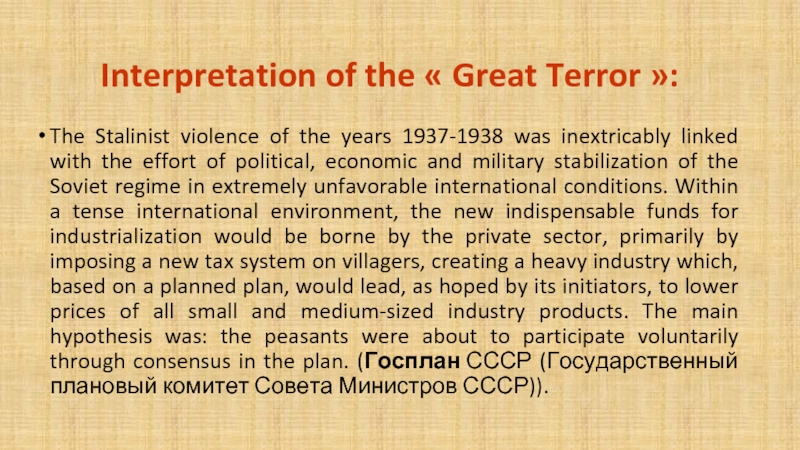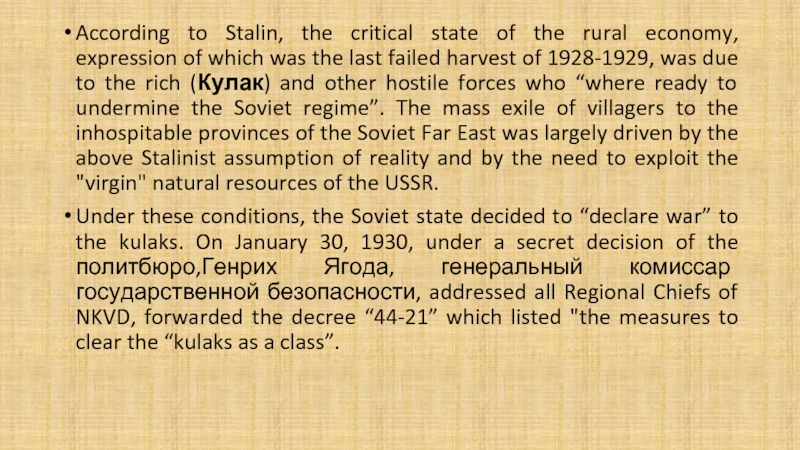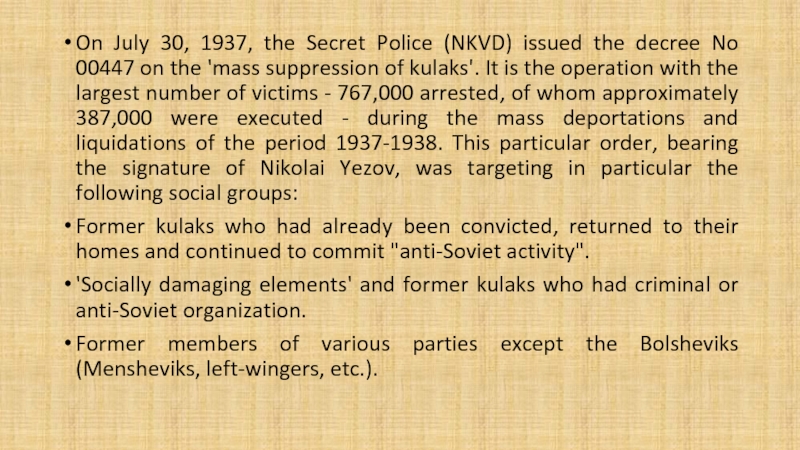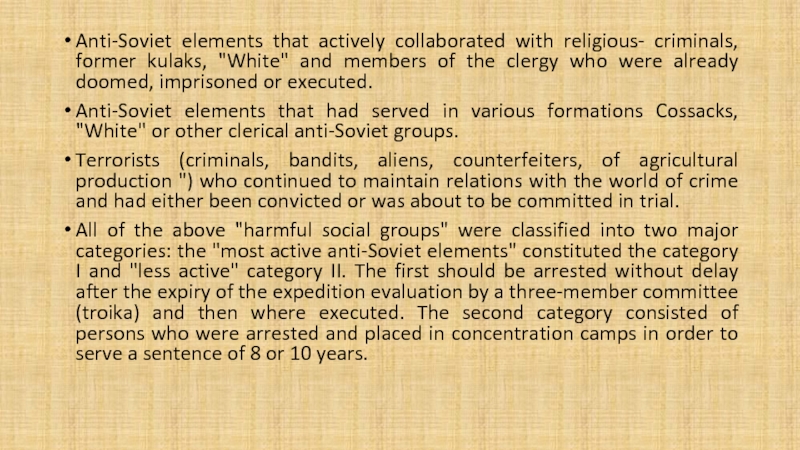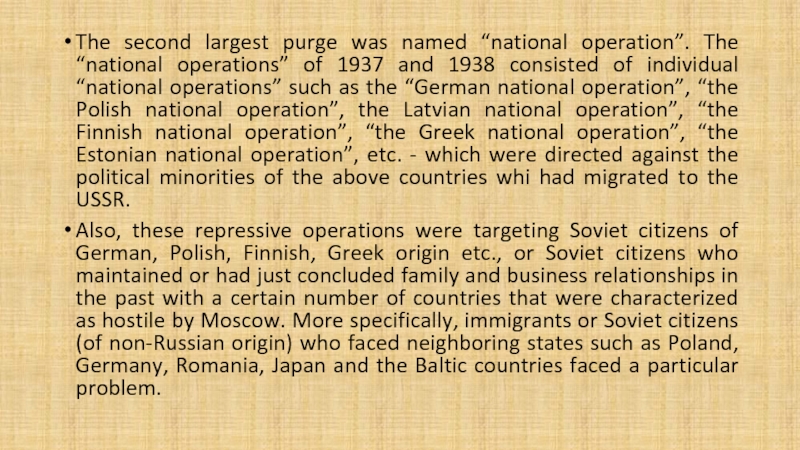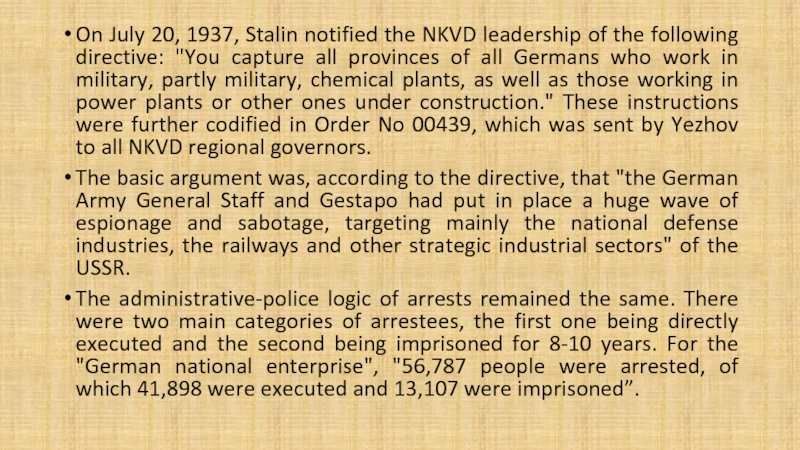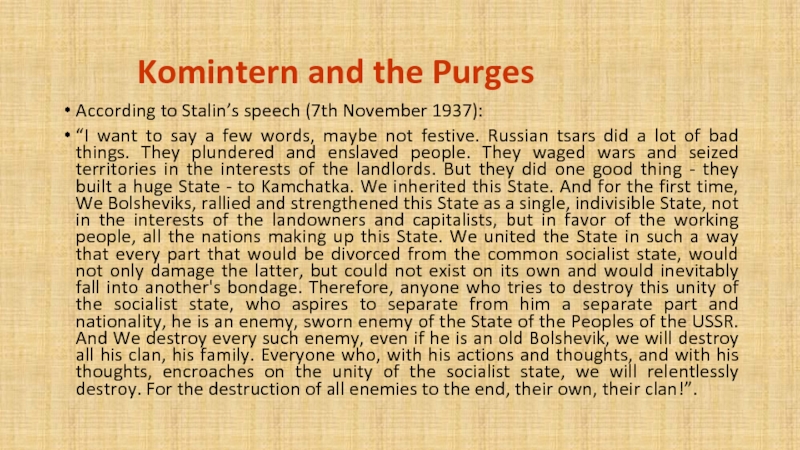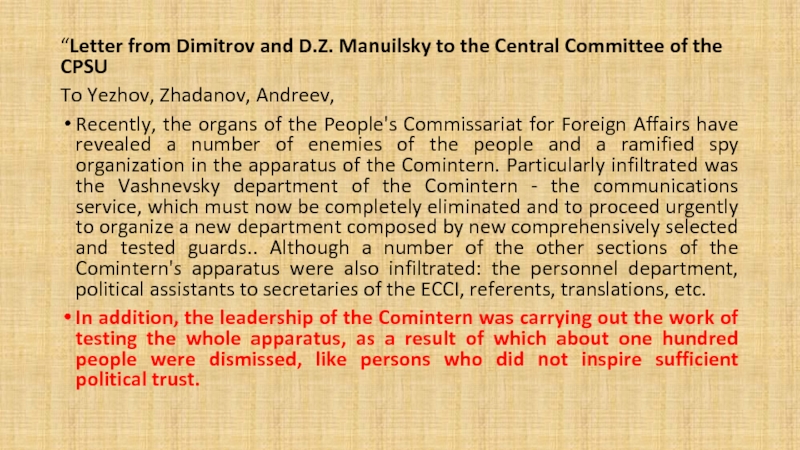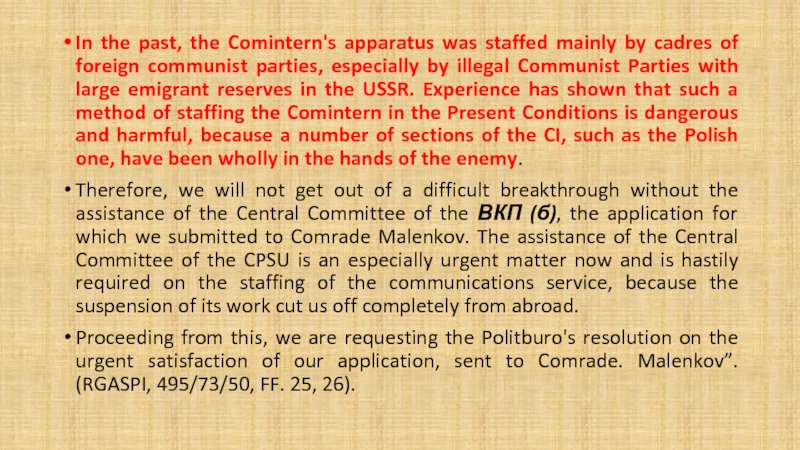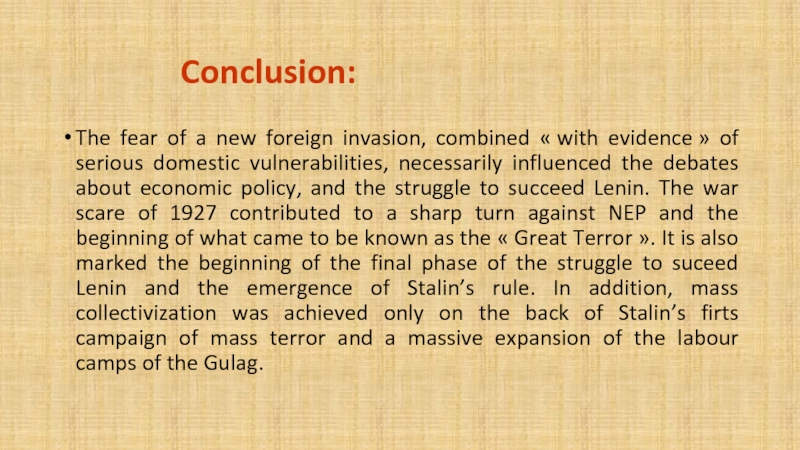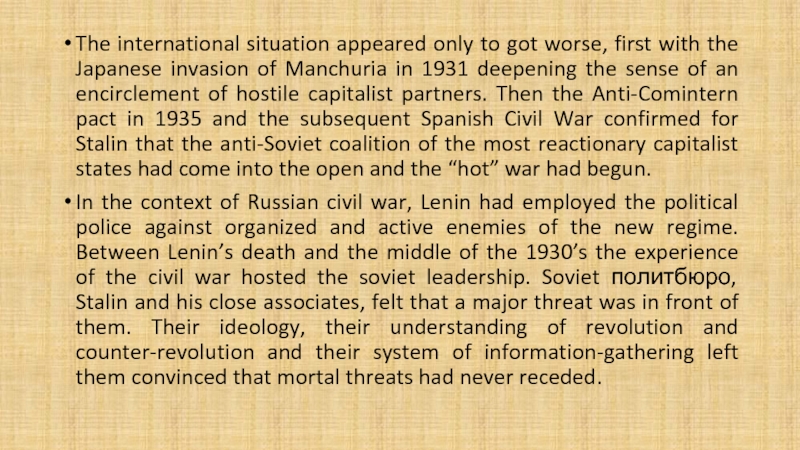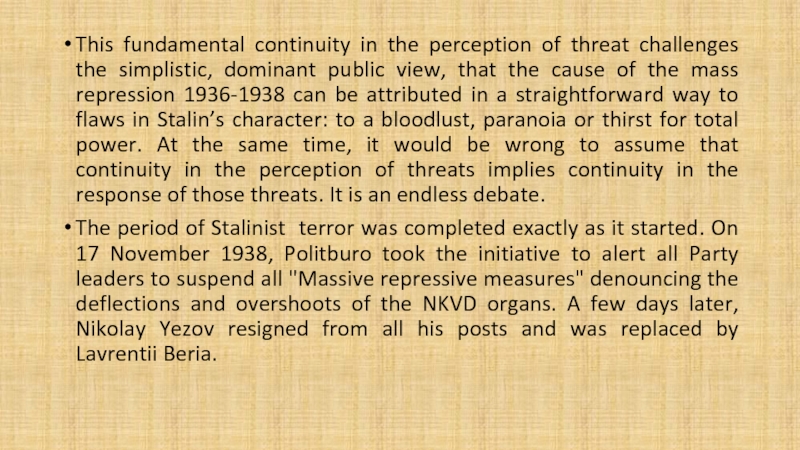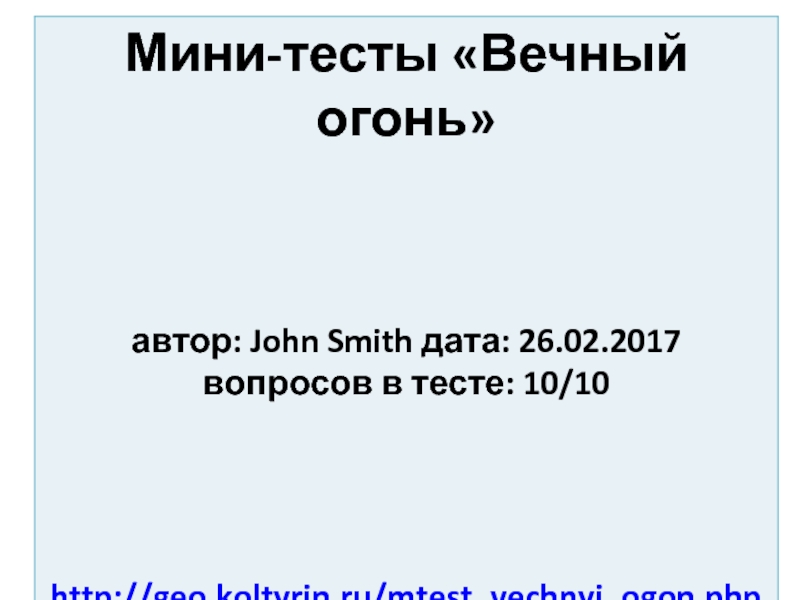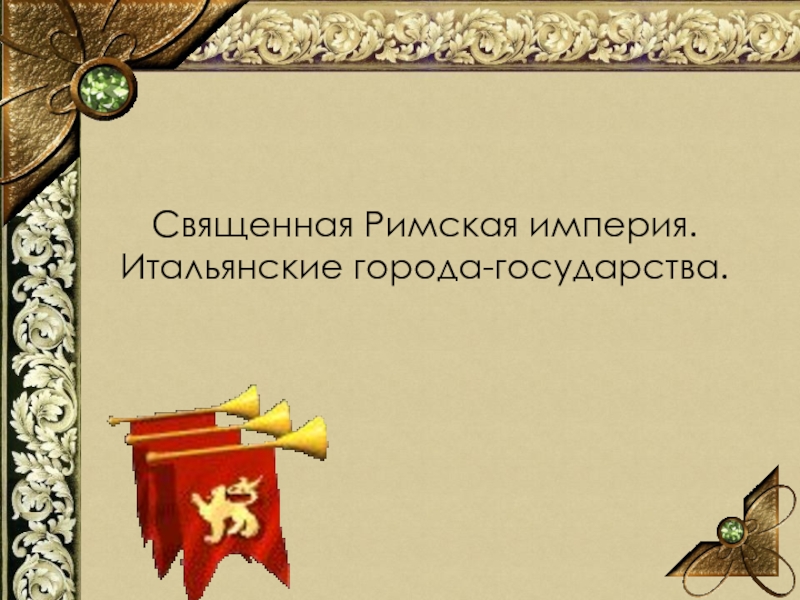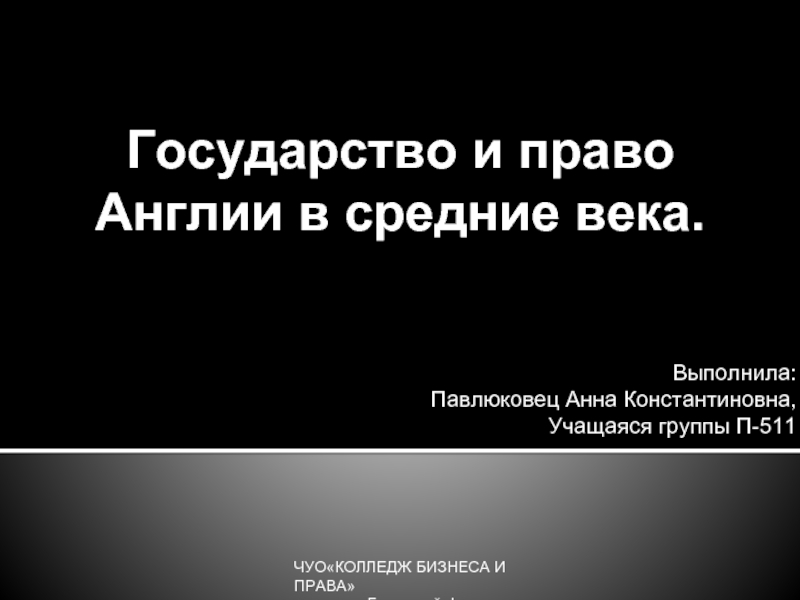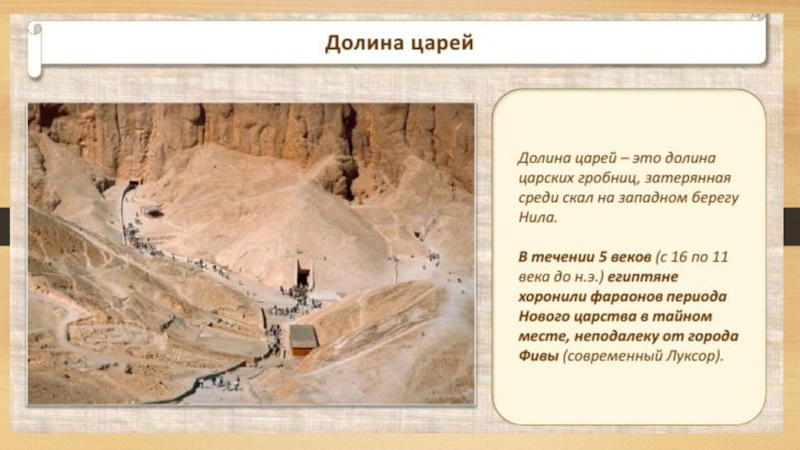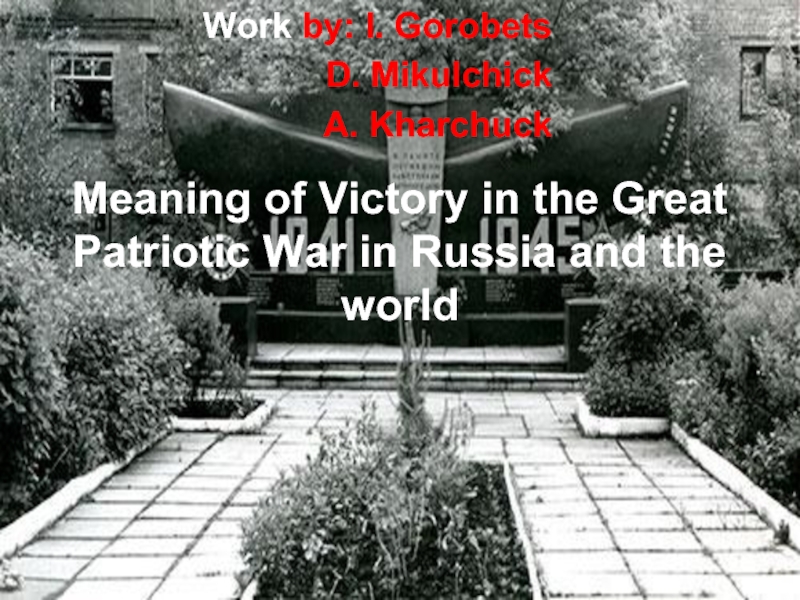- Главная
- Разное
- Дизайн
- Бизнес и предпринимательство
- Аналитика
- Образование
- Развлечения
- Красота и здоровье
- Финансы
- Государство
- Путешествия
- Спорт
- Недвижимость
- Армия
- Графика
- Культурология
- Еда и кулинария
- Лингвистика
- Английский язык
- Астрономия
- Алгебра
- Биология
- География
- Детские презентации
- Информатика
- История
- Литература
- Маркетинг
- Математика
- Медицина
- Менеджмент
- Музыка
- МХК
- Немецкий язык
- ОБЖ
- Обществознание
- Окружающий мир
- Педагогика
- Русский язык
- Технология
- Физика
- Философия
- Химия
- Шаблоны, картинки для презентаций
- Экология
- Экономика
- Юриспруденция
The comintern and the Western Communist Parties 1930-1949 презентация
Содержание
- 2. The comintern and the Western
- 3. The « Great Terror » THE GREAT PURGES OF
- 4. Debate in the West about the precise
- 5. The « Gullags » THE PENAL SYSTEM
- 6. We find also a system of labor
- 7. The « Great Terror »: The Moscow trials
- 8. Like a three-ring circus, each trial
- 11. The Great Terror followed the tremendous increase
- 12. The « Great Terror » The Great Terror of
- 13. All major countries (Germany, Poland, Japan, Britain,
- 14. Most if not all those repressed as
- 15. In August 1931, Stalin urged M.M. Litvinov,
- 16. Stalin wrote in 1945: “The defeat of
- 17. In order to carry out the
- 18. Stalin also often
- 19. Before Adolf Hitler’s ascension to power, Poland
- 20. In 1923 Japan invited the Polish specialist
- 21. Much of Poland’s anti-Soviet intelligence was carried
- 22. This sort of caution was sensible, given
- 23. A few months later, he reported that
- 24. In early July 1926, Дзержинский wrote to
- 25. An example: Jerzy Niezbrzycki (Ryszard Wraga), a
- 26. One of the most important strategic goals
- 27. The most important group for the “Promethean
- 28. In May of that year, according to
- 29. According to Soviet data, between 1922 and
- 30. Likewise, many Ukrainian émigré organizations in Poland
- 31. By the mid-1930s, like ethnic Germans, ethnic
- 32. Like other countries, Japan used its diplomatic
- 33. Like Poland, Japan showed keen interest in
- 34. Japan and Poland had common political and
- 35. After the Polish-German non-aggression pact signed in
- 36. Meanwhile, the NKVD, now headed by Nikolai
- 37. Alexander Orlov, a former NKVD official noted
- 38. The Great Terror was a precautionary strike
- 39. In October 1938, when he was ending
- 40. The Stalinist violence of the years 1937-1938
- 41. According to Stalin, the critical state of
- 42. On July 30, 1937, the Secret Police
- 43. Anti-Soviet elements that actively collaborated with religious-
- 44. The second largest purge was named “national
- 45. On July 20, 1937, Stalin notified the
- 46. Komintern and the Purges According to
- 47. “Letter from Dimitrov and D.Z. Manuilsky to
- 48. In the past, the Comintern's apparatus was
- 49. Conclusion: The fear of a new foreign
- 50. The international situation appeared only to got
- 51. This fundamental continuity in the perception of
Слайд 2 The comintern and the Western Communist Parties 1930-1949 Dr. Nikolaos
Слайд 3 The « Great Terror »
THE GREAT PURGES OF THE 1930s were a maelstrom
Слайд 4Debate in the West about the precise numbers of victims has
Soviet secret police documents are available that permit us to narrow sharply the range of estimates of victims of the Great Purges. These materials are from the archival records of the Secretariat of GULAG, the Main Camp Administration of the NKVD/MVD (the USSR Ministry of the Interior). We need also take into consideration the State Archive of the Russian Federation (GARF).
Слайд 5 The « Gullags »
THE PENAL SYSTEM ADMINISTERED BY THE NKVD (Peoples'
Слайд 6We find also a system of labor camps. These were the
There was the network of "special resettlements." In the 1930s, these areas were populated largely by peasant families deported from the central districts as "kulaks" (well-to-do peasants) during the forced collectivization of the early 1930s. There was a system of non-custodial "corrective work" (исправительно трудовые работы), which included various penalties and fines.
Слайд 7 The « Great Terror »: The Moscow trials
In March 1938, the veteran Bolshevik
Слайд 8 Like a three-ring circus, each trial was more flamboyant than
These three show trials were merely the public face of a far deeper and broader reign of repression. In between the second and third trials, in June 1937, the Soviet government announced that several senior military leaders, including Marshal Mikhail Tukhachevsky, had been found guilty of treason, and had been executed. All the while, the Soviet press was providing long lists of names of officials who had been purged for their alleged involvement in heinous activities against the Soviet state, and plenty more were disappearing without notice.
Слайд 11The Great Terror followed the tremendous increase in state coercion and
The period from mid-1937 to late 1938, the Ежовщина, was the full-blown Terror, marked most publicly by the Moscow Trials 1936-1938. The Terror affected practically every corner of the Soviet regime. The party’s top and middle cadre, by then mostly loyal to the general Stalinist line, was purged, often with the lower echelons whipping up a witch-hunt atmosphere against them. The military leadership and industrial management structures were particularly badly hit, as were party leaderships in the non-Russian republics, but no government department escaped, and soon nobody at all was safe as the dragnet descended to the rank-and-file worker and peasant. Brutal interrogation resulted in those arrested implicating others, some people denounced others for personal revenge or in the hopes of obtaining their jobs; few indeed could escape suspicion, few knew who to trust. The personal cost was tremendous, Conquest states that ‘the Terror destroyed personal confidence between private citizens everywhere’. Eventually, towards the end of 1938, the Great Terror was reined in.
Слайд 12 The « Great Terror »
The Great Terror of 1937-1938 took place against the
This is understandable, given that wars with Poland and Japan were much more limited: the September 1939 war with Poland was one-sided and swift with Poland easily dismembered; and the August 1945 war against Japan/Manchukuo was equally one-sided and swift with Japan decisively defeated. Yet, surprisingly the numbers of repressed at the time of the Great Terror as Polish and Japanese spies and agents far surpassed those repressed as German spies and agents. The NKVD statistics show that in 1937-1938, 101,965 people were arrested as Polish spies, 52,906 as Japanese spies and 39,300 as German spies to be followed by Latvian, Finnish, Estonian, Romanian, Greek and other “spies.”
Слайд 13All major countries (Germany, Poland, Japan, Britain, France and others) engaged
According to Stalin, spying did not necessarily consist of placing secret agents in foreign countries: it also consisted of such mundane tasks as the clipping of newspapers. By this logic, nearly every newspaper reader could be considered a foreign spy. Not merely reading but entertaining a certain thought was tantamount to spying, according to L.M. Kaganovich who said in December 1936, “If they stand for [the] defeat [of the Soviet Union], it’s clear that they are spies.”
He said in May 1937, “From the point of view of intelligence, we cannot have friends: there are clear enemies and there are potential enemies. So we cannot reveal any secrets to anyone.” By contrast, Poland and Japan exchanged intelligence and appeared to trust one another. They therefore must have appeared all the more dangerous to Stalin.
Слайд 14Most if not all those repressed as Polish “spies” were arrested
Also, Polish and Japanese “spies” were arrested according to other special operations, particularly NKVD Order No. 00693 dated 23 October 1937 (which mandated the arrest of all people who had defected to the Soviet Union by crossing international borders, regardless of the motives and circumstances of their defections and NKVD Order No. 00698 dated 28 October 1937 (to “arrest all Soviet citizens who are connected to the staff of foreign diplomatic offices and who visit their businesses and private premises” and to “place under constant surveillance all members of the German, Japanese, Polish and Italian embassies”).
Слайд 15In August 1931, Stalin urged M.M. Litvinov, the Soviet Commissar of
Indeed in 1932, with the tension mounting in the east dramatically owing to Japan’s invasion of Manchuria in September 1931, Stalin succeeded in concluding non-aggression pacts with Poland. (Stalin concluded similar treaties with France, Estonia, Latvia and Finland at the time.).
As for Japan, it is known that Stalin considered the territorial loss in the 1904- 1905 Russo-Japanese War a national insult. Very fond of listening to the music “On the Hills of Manchuria” by I.A. Shatrov (the lyrics of which by S. Petrov includes lines such as “You fell for Rus, perished for Fatherland, / Believe us, we shall avenge you / And celebrate a bloody wake”), he appeared bent on taking revenge.
The « Great Terror » and nationalities:
Слайд 16Stalin wrote in 1945:
“The defeat of the Russian forces in 1904
In 1931 Stalin gave a speech about Russian history as a history of “continual beatings owing to backwardness,” beatings by the Mongol khans, the Swedish feudal lords, the Polish-Lithuanian pans, the Anglo-French capitalists and the Japanese barons.
In 1937, anti-Japanese sentiment was such that when, out of diplomatic concern, Litvinov refused to sanction the arrest of a Japanese citizen on the island of Sakhalin, he had to qualify his refusal: “It is perfectly reasonable to suspect that all Japanese in the USSR are spies without exception.”
Слайд 17
In order to carry out the Polish Operation, A.I. Uspenskii, the
Nevertheless, Stalin’s anti-Polonism and other national prejudices did not play a central causal role in the Great Terror. As is seen in the case of Japan, it was state interests that guided Stalin. According to the US President Harry Truman, Stalin said, “it would be incorrect to be guided by injuries or feelings of retribution”: such feelings are “poor advisers in politics.”
In 1945, Stalin told the visiting Czechoslovaks:
“I hate the Germans, but hatred must not hinder us from objectively assessing them. The Germans are a great people, very good technical people and organisers. Good, innately brave soldiers. It’s impossible to eliminate them. They’ll stay”.
Слайд 18
Stalin also often praised Poland as a “good nation” and the
Слайд 19Before Adolf Hitler’s ascension to power, Poland and Japan presented the
Poland considered the Soviet Union, along with Germany, the greatest threat to its hard-won independence while Japan regarded the Soviet Union, along with the USA, as the greatest obstacle to its imperialist ambitions. In other words, the Soviet Union was a hypothetical enemy for both Poland and Japan, and they acted accordingly. The Soviet Union responded in kind. The two sides actively spied on each other. In this triangular relationship, Poland and Japan found common ground and cooperated, a cooperation that dates back to the 1904-1905 Russo-Japanese War.
The problem of Intelligence :
Слайд 20In 1923 Japan invited the Polish specialist of Russian/Soviet cyphers Jan
In both Poland and Japan, not all politicians and military leaders considered Soviet Union the most dangerous potential enemy. In Poland, opinions split as to which posed the greater danger, Germany or the Soviet Union. Similarly, in Japan, there was a split in assessing the relative danger of the USSR and the USA. Nevertheless, neither country neglected anti-Soviet intelligence after the Russian Civil War ended and diplomatic relations had been established with the Soviet Union.
Слайд 21Much of Poland’s anti-Soviet intelligence was carried out by the Dwójka,
The pre-history of this action: Soviet leaders were also convinced that Britain and France stood financially and military behind the polish forces that attacked Bolshevik Russia in the Spring of 1920. (RGASPI: 588/11/1180, f.53). When the campaign suddenly went badly wrong for the poles and soviet forces were on the outskirts of Warsaw, a contingent of French military advices under General Maxim Weygand helped chase the Red Army out of Poland. After a peace was negotiated, the Bolsheviks watched carefully as the French continued to contribute money and arms to the polish and Romanian armies. (Pravda, 18.12.1921). For France, close ties with strong and stable regimes in eastern and southern Europe was a critical part of her strategy to contain Germany. Soviet leaders continued nevertheless to see the diplomatic and military ties among Britain, France, the Balkan states, Romania, Poland, the Baltic states, and Finland as evidence of a long-term plan to prepare a new assault on them.
Слайд 22This sort of caution was sensible, given that these countries had
In November 1925, Dzerzhinski passed to Stalin reports to the effect that Britain was trying to promote a deal that would end the trade war between Poland and Germany and resolve tensions over disputed borders. (RGASPI: 76/3/364, ff. 23-31).
Слайд 23A few months later, he reported that the British were canvassing
Iagoda (Генрих Григорьевич Ягoда), one of the main leaders of the Soviet state security bodies (the Cheka, the GPU, the OGPU, the NKVD), the People's Commissar for Internal Affairs of the USSR (1934-1936), the first ever "General Commissioner of State Security“, stated on 14.04.1926: “Materials in our possession which confirm beyond doubt that on the instructions of the English, the Polish and other general Staffs of countries on our western borders have begun broad subversive work against the USSR and have increased their espionage network on our territory… Measures are being taken…”.
Слайд 24In early July 1926, Дзержинский wrote to Stalin asserting that “there
Throughout 1920, the intelligence services had warned that foreign governments were building networks of agents within the USSR whose task was to undermine soviet power from within by means of the sabotage of factories and infrastructure, the assassination of officials, and the organization of a fifth column in the event of war.
Taking the above into account, in 1937 there were more than 636,000 ethnic Poles in the Soviet Union, about seventy percent of them in Ukraine, on whose service Poland expected to draw. During WWI Piłsudski, the future leader of Poland, had founded a secret military organisation (Polska Organizacja Wojskowa, POW) for the purpose of intelligence and subversion against Poland’s enemies (Russia, later Soviet Russia, and Germany). Although it ceased to exist after the Polish-Soviet War of 1919- 1920, the Dwójka absorbed many of its members, inherited its expertise and sought to utilise the remnants of its conspiratorial organisational structures in the Soviet Union.
Слайд 25An example: Jerzy Niezbrzycki (Ryszard Wraga), a native of Ukraine and
As Niezbrzycki’s case suggests, Poland, probably like many other countries and certainly Japan and the Soviet Union, used diplomatic missions extensively to cover its intelligence activity. Until 1937 Poland maintained consulates in Moscow, Leningrad, Kharkiv, Kyiv, Minsk and Tiflis where they ran intelligence operations. Diplomatic posts in other key countries, particularly those surrounding the Soviet Union such as Japan, Finland, Turkey, Latvia, Estonia and Czechoslovakia as well as Germany, France and Yugoslavia served the same purpose.
Слайд 26One of the most important strategic goals of independent Poland was
As Timothy Sander states: “It brought together grand strategists of Warsaw and exiled patriots [Ukrainians, Georgians, Azeris, and others] whose attempts to found independent states had been thwarted by the Bolsheviks [and was] supported by European powers hostile to the Soviet Union, morally by Britain and France, politically and financially by Poland”. (Timothy Snyder, Sketches from a Secret War: A Polish Artist’s Mission to Liberate Soviet Ukraine (New Haven, CT: Yale University Press, 2005), 40).
Слайд 27The most important group for the “Promethean movement” was Ukraine. Poland
Слайд 28In May of that year, according to an Japanese record intercepted
“the Japanese military attaché in Moscow, Torashirō Kawabe, enquired of his colleague in Warsaw, Hikosaburō Hata, whether the rumour he had heard in Moscow that two members of the Polish General Staff were executed for, espionage for the Soviet Union was true. Two days later, Hata, who worked closely with the Polish intelligence agency, responded: the Polish General Staff recently sent 20-odd secret agents to Ukraine, all of whom, however, were caught by the GPU. Two “secretaries” of the General Staff had been bought off by the Soviets and leaked secret information to them. They were court-marshaled and sentenced to be shot. The Kawabe-Hata correspondence was intercepted by the Soviet secret police and reported to Stalin”.
Слайд 29According to Soviet data, between 1922 and 1936, the Soviet Ukrainian
Слайд 30Likewise, many Ukrainian émigré organizations in Poland and elsewhere were penetrated
Both Poland and the Soviet Union acknowledged that they spied on each other. On a number of occasions in the 1920s and 1930s, the countries exchanged political prisoners (including spies), the last in 1936.
Слайд 31By the mid-1930s, like ethnic Germans, ethnic Poles in the Soviet
Shortly after the December 1934 murder of Sergei Kirov in Leningrad, Moscow began to deport ethnic Poles, Germans and Finns as well as other politically suspect from its border zones.
Слайд 32Like other countries, Japan used its diplomatic posts for intelligence. Not
Слайд 33Like Poland, Japan showed keen interest in the minorities within the
Some documents related to Japan’s espionage against the Soviet Union presumably lost in WWII later surfaced in Soviet hands and copies were submitted at the Tokyo Trial as evidence of Japan’s anti-Soviet machinations. Japan targeted Trotsky supporters inside and outside the Soviet Union for possible agents. In 1931-1932, the Japanese military attaché in Warsaw Hikosaburō Hata worked closely with émigré Muslim leaders against the Soviet Union.
Слайд 34Japan and Poland had common political and military interests and worked
The Soviet secret police also penetrated the office of the military attaché in the Japanese Embassy. In December 1931 and February 1932 two stolen memoranda from the embassy were circulated among the Politburo members. In one of them dated 19 December 1931, that is after Japan’s conquest of Manchuria, the Japanese Ambassador in Moscow Kōki Hirota was quoted as having conveyed the following opinion to the Japanese General Staff in Tokyo:
“On the question of whether Japan should declare war on the Soviet Union — I deem it necessary that Japan be ready to declare war at any moment and to adopt a tough policy towards the Soviet Union. The cardinal objective of this war must lie not so much in protecting Japan from Communism as in seizing the Soviet Far East and Eastern Siberia”. (N. Khaustov, V.P. Naumov, N.S. Plotnikova, Lubianka: Stalin i VChK-GPU-OGPUNKVD. Ianvar´ 1922-dekabr´ 1936 [The Lubianka: Stalin and VchK-GPU-NKVD, January 1922-December 1936] (M.: Mezhdunarodnyi fond demokratsii, 2003, 292, 295).
Слайд 35After the Polish-German non-aggression pact signed in January 1934 and Poland’s
The Soviet Union increased its subversion against Poland and its military by using Comintern agents and Communists. The tension in the east led to the “Great Terror” in Mongolia, engineered by Stalin in 1937. On 27 November 1934 the Soviet Union concluded a treaty of mutual military assistance with Mongolia. On 12 March 1936 the Soviet Union and Mongolia renewed their treaty of mutual aid for ten years. In the mean time Japan/Manchukuo and Mongolia had a number of border clashes. Manchukuo and Mongolia held meetings to resolve the border issues. When it was announced on 25 November 1936 that Germany and Japan had signed an agreement (Anti-Comintern Pact), the Mongolian delegation left the negotiation table.
The Terror of the soviet state:
Слайд 36Meanwhile, the NKVD, now headed by Nikolai Ezhov, reassessed its foreign
The secret police became alarmingly concerned about the penetration of Soviet organizations by foreign intelligence. Ezhov entertained deep suspicion of his predecessor’s (Iagoda’s) foreign operatives. It is also true that the Soviet Union used fake deserters extensively to penetrate foreign countries: the secret police used its agents as convinced anti- Soviet defectors to fool foreign intelligence.
Слайд 37Alexander Orlov, a former NKVD official noted that:
“Stalin used to say:
Late in his life, Molotov told his interviewer that every day he used to spend half a day reading intelligence reports, but insisted that it was impossible to rely on spies, who “could push you into such a dangerous position that you would never get out of it”: “You have to listen to them, but you also have to verify their information.” In June 1937, Stalin contended that in all spheres but one, the Soviet government had defeated the international bourgeoisie, which, however, had beaten the Soviet government effortlessly in the area of intelligence operations.
Слайд 38The Great Terror was a precautionary strike against people who could
According to Nikita Khrushchev, Stalin believed that “Ten percent of the truth is still the truth. It requires decisive action on our part, and we will pay for it if we don’t act accordingly”.
There is much evidence that Stalin believed in the ninety percent of the truth, but used the ten remaining percent for his political purposes.
Слайд 39In October 1938, when he was ending the Great Terror, Stalin
“Well, were they all spies? Of course, not. Whatever happened to them? They were cadres who could not stomach the sharp turn toward collective farms and could not make sense of this turn, because they were not trained politically, did not know the laws of social development, the laws of economic development, the laws of political development. […]How to explain that some of them became spies and intelligence agents? […] It turns out that they were not well-grounded politically and not well grounded theoretically. They turned out to be people who did not know the laws of political development, and therefore they could not stomach the sharp turn”.
Слайд 40The Stalinist violence of the years 1937-1938 was inextricably linked with
Interpretation of the « Great Terror »:
Слайд 41According to Stalin, the critical state of the rural economy, expression
Under these conditions, the Soviet state decided to “declare war” to the kulaks. On January 30, 1930, under a secret decision of the политбюро,Генрих Ягода, генеральный комиссар государственной безопасности, addressed all Regional Chiefs of NKVD, forwarded the decree “44-21” which listed "the measures to clear the “kulaks as a class”.
Слайд 42On July 30, 1937, the Secret Police (NKVD) issued the decree
Former kulaks who had already been convicted, returned to their homes and continued to commit "anti-Soviet activity".
'Socially damaging elements' and former kulaks who had criminal or anti-Soviet organization.
Former members of various parties except the Bolsheviks (Mensheviks, left-wingers, etc.).
Слайд 43Anti-Soviet elements that actively collaborated with religious- criminals, former kulaks, "White"
Anti-Soviet elements that had served in various formations Cossacks, "White" or other clerical anti-Soviet groups.
Terrorists (criminals, bandits, aliens, counterfeiters, of agricultural production ") who continued to maintain relations with the world of crime and had either been convicted or was about to be committed in trial.
All of the above "harmful social groups" were classified into two major categories: the "most active anti-Soviet elements" constituted the category I and "less active" category II. The first should be arrested without delay after the expiry of the expedition evaluation by a three-member committee (troika) and then where executed. The second category consisted of persons who were arrested and placed in concentration camps in order to serve a sentence of 8 or 10 years.
Слайд 44The second largest purge was named “national operation”. The “national operations”
Also, these repressive operations were targeting Soviet citizens of German, Polish, Finnish, Greek origin etc., or Soviet citizens who maintained or had just concluded family and business relationships in the past with a certain number of countries that were characterized as hostile by Moscow. More specifically, immigrants or Soviet citizens (of non-Russian origin) who faced neighboring states such as Poland, Germany, Romania, Japan and the Baltic countries faced a particular problem.
Слайд 45On July 20, 1937, Stalin notified the NKVD leadership of the
The basic argument was, according to the directive, that "the German Army General Staff and Gestapo had put in place a huge wave of espionage and sabotage, targeting mainly the national defense industries, the railways and other strategic industrial sectors" of the USSR.
The administrative-police logic of arrests remained the same. There were two main categories of arrestees, the first one being directly executed and the second being imprisoned for 8-10 years. For the "German national enterprise", "56,787 people were arrested, of which 41,898 were executed and 13,107 were imprisoned”.
Слайд 46 Komintern and the Purges
According to Stalin’s speech (7th November 1937):
“I
Слайд 47“Letter from Dimitrov and D.Z. Manuilsky to the Central Committee of
To Yezhov, Zhadanov, Andreev,
Recently, the organs of the People's Commissariat for Foreign Affairs have revealed a number of enemies of the people and a ramified spy organization in the apparatus of the Comintern. Particularly infiltrated was the Vashnevsky department of the Comintern - the communications service, which must now be completely eliminated and to proceed urgently to organize a new department composed by new comprehensively selected and tested guards.. Although a number of the other sections of the Comintern's apparatus were also infiltrated: the personnel department, political assistants to secretaries of the ECCI, referents, translations, etc.
In addition, the leadership of the Comintern was carrying out the work of testing the whole apparatus, as a result of which about one hundred people were dismissed, like persons who did not inspire sufficient political trust.
Слайд 48In the past, the Comintern's apparatus was staffed mainly by cadres
Therefore, we will not get out of a difficult breakthrough without the assistance of the Central Committee of the ВКП (б), the application for which we submitted to Comrade Malenkov. The assistance of the Central Committee of the CPSU is an especially urgent matter now and is hastily required on the staffing of the communications service, because the suspension of its work cut us off completely from abroad.
Proceeding from this, we are requesting the Politburo's resolution on the urgent satisfaction of our application, sent to Comrade. Malenkov”. (RGASPI, 495/73/50, FF. 25, 26).
Слайд 49 Conclusion:
The fear of a new foreign invasion, combined « with evidence » of
Слайд 50The international situation appeared only to got worse, first with the
In the context of Russian civil war, Lenin had employed the political police against organized and active enemies of the new regime. Between Lenin’s death and the middle of the 1930’s the experience of the civil war hosted the soviet leadership. Soviet политбюро, Stalin and his close associates, felt that a major threat was in front of them. Their ideology, their understanding of revolution and counter-revolution and their system of information-gathering left them convinced that mortal threats had never receded.
Слайд 51This fundamental continuity in the perception of threat challenges the simplistic,
The period of Stalinist terror was completed exactly as it started. On 17 November 1938, Politburo took the initiative to alert all Party leaders to suspend all "Massive repressive measures" denouncing the deflections and overshoots of the NKVD organs. A few days later, Nikolay Yezov resigned from all his posts and was replaced by Lavrentii Beria.

